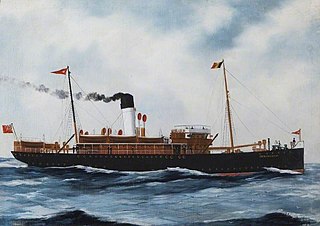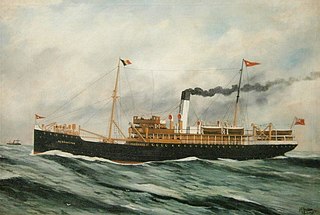
A steamship, often referred to as a steamer, is a type of steam-powered vessel, typically ocean-faring and seaworthy, that is propelled by one or more steam engines that typically move (turn) propellers or paddlewheels. The first steamships came into practical usage during the early 1800s; however, there were exceptions that came before. Steamships usually use the prefix designations of "PS" for paddle steamer or "SS" for screw steamer. As paddle steamers became less common, "SS" is assumed by many to stand for "steamship". Ships powered by internal combustion engines use a prefix such as "MV" for motor vessel, so it is not correct to use "SS" for most modern vessels.

The Great Central Railway in England was formed when the Manchester, Sheffield and Lincolnshire Railway changed its name in 1897, anticipating the opening in 1899 of its London Extension. On 1 January 1923, the company was grouped into the London and North Eastern Railway.

The Blue Riband is an unofficial accolade given to the passenger liner crossing the Atlantic Ocean in regular service with the record highest average speed. The term was borrowed from horse racing and was not widely used until after 1910. The record is based on average speed rather than passage time because ships follow different routes. Also, eastbound and westbound speed records are reckoned separately, as the more difficult westbound record voyage, against the Gulf Stream and the prevailing weather systems, typically results in lower average speeds.

A & J Inglis, Ltd, was a shipbuilding firm founded by Anthony Inglis and his brother John, engineers and shipbuilders in Glasgow, Scotland in 1862. The firm built over 500 ships in a period of just over 100 years. Their Pointhouse Shipyard was at the confluence of the rivers Clyde and Kelvin. They constructed a wide range of ships, including Clyde steamers, paddle steamers and small ocean liners. In wartime, they built small warships, and in the period after World War II, they built a number of whalers.

PS Lincoln Castle was a coal-fired side-wheel paddle steamer, which ferried passengers across the Humber from the 1941 until 1978. She was the last coal-fired paddle steamer still in regular services in the UK. Later, she served as a pub at Hessle, and then as a restaurant under permanent dock at Alexandra Dock, Grimsby. In September 2010, the Hull Daily Mail reported that she was in an advanced state of demolition, despite the efforts of local people to buy the historic vessel and restore her. On 31 March 2011, the Lincoln Castle Preservation Society were reported to have purchased the broken up parts of the ship for restoration.

RMS Lucania was a British ocean liner owned by the Cunard Steamship Line Shipping Company, built by Fairfield Shipbuilding and Engineering Company of Govan, Scotland, and launched on Thursday, 2 February 1893.
The West Cornwall Steam Ship Company was established in 1870 to operate ferry services between Penzance, Cornwall, and the Isles of Scilly. It became the West Cornwall Steamship Company in 1907 and was wound up in 1917.

Dakota was a steamship built by the Eastern Shipbuilding Company of Groton, Connecticut for the Great Northern Steamship Company owned by railroad magnate James J. Hill to enhance and promote trade between the United States and Japan.

SS Governor Cobb was an American coastal passenger steamboat built in 1906. The ship has the double distinction of being not only the first American-built ship to be powered by steam turbines, but also, late in her career, of becoming the world's first helicopter carrier.

Persia was a British passenger liner operated by the Cunard Line that won the Blue Riband in 1856 for the fastest westbound transatlantic voyage. She was the first Atlantic record breaker constructed of iron and was the largest ship in the world at the time of her launch. However, the inefficiencies of paddle wheel propulsion rendered Persia obsolete and she was taken out of service in 1868 after only twelve years. Attempts to convert Persia to sail were unsuccessful and the former pride of the British merchant marine was scrapped in 1872.

TS King Edward was an excursion steamer built at Dumbarton for service down the River Clyde to the Firth of Clyde and associated sea lochs on the west coast of Scotland, as far as Campbeltown. The first commercial vessel to be driven by steam turbines, King Edward was remarkably successful for a prototype, serving as a Clyde steamer for half a century from 1901 until 1951, interrupted only by service in the two world wars. The success of the vessel quickly led to the adoption of turbine propulsion for all manner of merchant vessels, from channel ferries and coastal steamers to transatlantic liners.
TSS Great Western was a passenger vessel built for the Great Western Railway in 1902.
SS Irwell was a freight vessel built for the Lancashire and Yorkshire Railway in 1906.
SS Lutterworth was a passenger and cargo vessel built for the Manchester, Sheffield and Lincolnshire Railway in 1891.

TrSS Immingham was a passenger and cargo vessel built for the Great Central Railway in 1906.

SS Accrington was a passenger and cargo vessel built for the Great Central Railway in 1910.

SS Dewsbury was a passenger and cargo vessel built for the Great Central Railway in 1910.
SS Oldham was a passenger and cargo vessel built for the Manchester, Sheffield and Lincolnshire Railway in 1888.
PS Killingholme was a passenger and cargo vessel built for the Great Central Railway in 1912.
Queen Cristina was a steam cargo ship built in 1901 by the Northumberland Shipbuilding Co of Newcastle for Thomas Dunlop & Sons of Glasgow. The ship was designed and built for general cargo trade and spent her career doing tramp trade. She was the second ship named Queen Cristina in service with the Queen Line.













